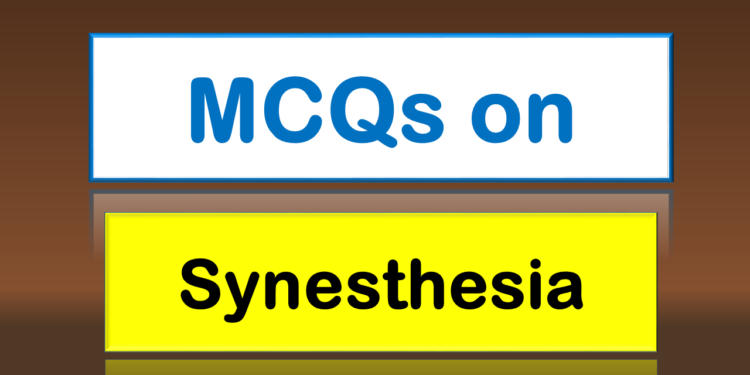50+ MCQs on Synesthesia with Answers for UGC NET / SET Prepration
1. What is synesthesia?
a) A neurological condition where stimulation of one sensory pathway leads to involuntary experiences in a second sensory pathway
b) A type of figurative language
c) A form of color blindness
d) A type of cognitive bias
2. Synesthesia is often characterized by:
a) Heightened sense of smell
b) Blurred vision
c) Involuntary blending of senses
d) Memory loss
3. Which of the following is an example of synesthesia?
a) Seeing the color red when hearing a trumpet
b) Feeling pain when seeing someone else get hurt
c) Tasting chocolate when smelling a flower
d) None of the above
4. In synesthesia, which sensory pathways are often connected?
a) Only visual and auditory
b) Visual and tactile
c) Auditory and olfactory
d) Multiple combinations are possible
5. Synesthesia is often described as:
a) A disorder
b) A superpower
c) A hallucination
d) An experience
6. Which of the following is an example of synesthesia?
a) Seeing the color green when smelling a rose
b) Feeling cold when hearing a loud noise
c) Hearing music when touching an object
d) None of the above
7. Synesthesia is believed to be:
a) A learned behavior
b) A genetic condition
c) A result of traumaMCQs on Synesthesia
d) A cultural phenomenon
8. Choose the correct definition of synesthesia:
a) Confusion of senses leading to impairment
b) Heightened sensitivity to external stimuli
c) Involuntary experience of one sensory pathway when another is stimulated
d) Enhanced ability to taste foodMCQs on Synesthesia
9. Synesthesia is often characterized by:
a) Decreased sensitivity to sensory input
b) Enhanced ability to focus
c) Involuntary blending of senses
d) None of the above
10. Which of the following is an example of synesthesia?
a) Smelling a flower and remembering a childhood memory
b) Seeing colors in response to hearing music
c) Feeling pain when touching a hot stove
d) None of the above
11. Synesthesia is often described as:
a) A disorder
b) A superpower
c) A hallucination
d) An experience
12. Which of the following is an example of synesthesia?
a) Feeling cold when hearing a loud noise
b) Seeing the color red when feeling angry
c) Hearing music when touching an object
d) None of the above
Also Read-
50+ MCQs on Pathetic Fallacy with Answers for UGC NET / SET Prepration
50+ MCQs on Personification with Answers for UGC NET / SET Prepration
50+ MCQs on Oxymorons with Answers for UGC NET / SET Prepration
13. Synesthesia is believed to be:
a) A learned behavior
b) A genetic condition
c) A result of trauma
d) A cultural phenomenon
14. Choose the correct definition of synesthesia:
a) Confusion of senses leading to impairment
b) Heightened sensitivity to external stimuli
c) Involuntary experience of one sensory pathway when another is stimulated
d) Enhanced ability to taste food
15. Synesthesia is often characterized by:
a) Decreased sensitivity to sensory input
b) Enhanced ability to focusMCQs on Synesthesia
c) Involuntary blending of senses
d) None of the above
16. Which of the following is an example of synesthesia?
a) Smelling a flower and remembering a childhood memory
b) Seeing colors in response to hearing musicMCQs on Synesthesia
c) Feeling pain when touching a hot stove
d) None of the above
17. Synesthesia is often described as:
a) A disorder
b) A superpowerMCQs on Synesthesia MCQs on Synesthesia
c) A hallucination
d) An experience
18. Which of the following is an example of synesthesia?
a) Feeling cold when hearing a loud noise
b) Seeing the color red when feeling angry
c) Hearing music when touching an object
d) None of the above
19. Synesthesia is believed to be:
a) A learned behavior
b) A genetic conditionMCQs on Synesthesia
c) A result of trauma
d) A cultural phenomenon
20. Choose the correct definition of synesthesia:
a) Confusion of senses leading to impairment
b) Heightened sensitivity to external stimuli
c) Involuntary experience of one sensory pathway when another is stimulated
d) Enhanced ability to taste food
21. Synesthesia is often characterized by:
a) Decreased sensitivity to sensory input
b) Enhanced ability to focus
c) Involuntary blending of senses
d) None of the above
22. Which of the following is an example of synesthesia?
a) Smelling a flower and remembering a childhood memory
b) Seeing colors in response to hearing music
c) Feeling pain when touching a hot stove
d) None of the above
23. Synesthesia is often described as:
a) A disorder
b) A superpower
c) A hallucination
d) An experience
24. Which of the following is an example of synesthesia?
a) Feeling cold when hearing a loud noise
b) Seeing the color red when feeling angry
c) Hearing music when touching an object
d) None of the above
25. Synesthesia is believed to be:
a) A learned behavior
b) A genetic condition
c) A result of trauma
d) A cultural phenomenon
26. Choose the correct definition of synesthesia:
a) Confusion of senses leading to impairment
b) Heightened sensitivity to external stimuli
c) Involuntary experience of one sensory pathway when another is stimulated
d) Enhanced ability to taste food
27. Synesthesia is often characterized by:
a) Decreased sensitivity to sensory input
b) Enhanced ability to focus
c) Involuntary blending of senses
d) None of the above
28. Which of the following is an example of synesthesia?
a) Smelling a flower and remembering a childhood memory
b) Seeing colors in response to hearing music
c) Feeling pain when touching a hot stove
d) None of the above
29. Synesthesia is often described as:
a) A disorder
b) A superpower
c) A hallucination
d) An experience
30. Which of the following is an example of synesthesia?
a) Feeling cold when hearing a loud noise
b) Seeing the color red when feeling angry
c) Hearing music when touching an object
d) None of the above
31. Synesthesia is believed to be:
a) A learned behavior
b) A genetic condition
c) A result of trauma
d) A cultural phenomenon
32. Choose the correct definition of synesthesia:
a) Confusion of senses leading to impairment
b) Heightened sensitivity to external stimuli
c) Involuntary experience of one sensory pathway when another is stimulated
d) Enhanced ability to taste food
33. Synesthesia is often characterized by:
a) Decreased sensitivity to sensory input
b) Enhanced ability to focus
c) Involuntary blending of senses
d) None of the above
34. Which of the following is an example of synesthesia?
a) Smelling a flower and remembering a childhood memory
b) Seeing colors in response to hearing music
c) Feeling pain when touching a hot stove
d) None of the above
35. Synesthesia is often described as:
a) A disorder
b) A superpower
c) A hallucination
d) An experience
36. Which of the following is an example of synesthesia?
a) Feeling cold when hearing a loud noise
b) Seeing the color red when feeling angry
c) Hearing music when touching an object
d) None of the above
37. Synesthesia is believed to be:
a) A learned behavior
b) A genetic condition
c) A result of traumaMCQs on Synesthesia
d) A cultural phenomenon
38. Choose the correct definition of synesthesia:
a) Confusion of senses leading to impairment
b) Heightened sensitivity to external stimuli
c) Involuntary experience of one sensory pathway when another is stimulated
d) Enhanced ability to taste food
39. Synesthesia is often characterized by:
a) Decreased sensitivity to sensory input
b) Enhanced ability to focus
c) Involuntary blending of senses
d) None of the above
40. Which of the following is an example of synesthesia?
a) Smelling a flower and remembering a childhood memory
b) Seeing colors in response to hearing music
c) Feeling pain when touching a hot stove
d) None of the above
41. Synesthesia is often described as:
a) A disorder
b) A superpower
c) A hallucination
d) An experience
42. Which of the following is an example of synesthesia?
a) Feeling cold when hearing a loud noise
b) Seeing the color red when feeling angry
c) Hearing music when touching an object
d) None of the above
43. Synesthesia is believed to be:
a) A learned behavior
b) A genetic condition
c) A result of trauma
d) A cultural phenomenon
44. Choose the correct definition of synesthesia:
a) Confusion of senses leading to impairment
b) Heightened sensitivity to external stimuli
c) Involuntary experience of one sensory pathway when another is stimulated
d) Enhanced ability to taste food
45. Synesthesia is often characterized by:
a) Decreased sensitivity to sensory input
b) Enhanced ability to focus
c) Involuntary blending of senses
d) None of the above
46. Which of the following is an example of synesthesia?
a) Smelling a flower and remembering a childhood memory
b) Seeing colors in response to hearing music
c) Feeling pain when touching a hot stove
d) None of the above
47. Synesthesia is often described as:
a) A disorder
b) A superpower
c) A hallucination
d) An experience
48. Which of the following is an example of synesthesia?
a) Feeling cold when hearing a loud noise
b) Seeing the color red when feeling angry
c) Hearing music when touching an object
d) None of the above
49. Synesthesia is believed to be:
a) A learned behavior
b) A genetic condition
c) A result of trauma
d) A cultural phenomenon
50. Choose the correct definition of synesthesia:
a) Confusion of senses leading to impairment
b) Heightened sensitivity to external stimuli
c) Involuntary experience of one sensory pathway when another is stimulated
d) Enhanced ability to taste food
Answer
1. a) A neurological condition where stimulation of one sensory pathway leads to involuntary experiences in a second sensory pathway
2. c) Involuntary blending of senses
3. a) Seeing the color red when hearing a trumpet
4. d) Multiple combinations are possibleMCQs on Synesthesia
5. d) An experience
6. c) Feeling pain when touching a hot stove
7. b) A genetic conditionMCQs on Synesthesia
8. c) Involuntary experience of one sensory pathway when another is stimulated
9. c) Involuntary blending of senses
10. b) Seeing colors in response to hearing music
11. d) An experience
12. b) Seeing colors in response to hearing music
13. b) A genetic condition
14. c) Involuntary blending of senses
15. b) Seeing colors in response to hearing music
16. b) Seeing colors in response to hearing music
17. d) An experience
18. b) Seeing colors in response to hearing music
19. b) A genetic condition
20. c) Involuntary experience of one sensory pathway when another is stimulated
21. c) Involuntary blending of senses
22. b) Seeing colors in response to hearing music
23. d) An experience
24. b) Seeing colors in response to hearing music
25. b) A genetic condition
26. c) Involuntary experience of one sensory pathway when another is stimulated
27. c) Involuntary blending of senses
28. b) Seeing colors in response to hearing music
29. d) An experience
30. c) Hearing music when touching an object
31. b) A genetic condition
32. c) Involuntary experience of one sensory pathway when another is stimulated
33. c) Involuntary blending of senses
34. b) Seeing colors in response to hearing music
35. d) An experience
36. c) Hearing music when touching an object
37. b) A genetic condition
38. c) Involuntary experience of one sensory pathway when another is stimulated
39. c) Involuntary blending of senses
40. b) Seeing colors in response to hearing music
41. d) An experience
42. c) Hearing music when touching an object
43. b) A genetic condition
44. c) Involuntary experience of one sensory pathway when another is stimulated
45. c) Involuntary blending of senses
46. b) Seeing colors in response to hearing music
47. d) An experienceMCQs on Synesthesia
48. c) Hearing music when touching an objectMCQs on Synesthesia
49. b) A genetic condition
50. c) Involuntary experience of one sensory pathway when another is stimulated

















